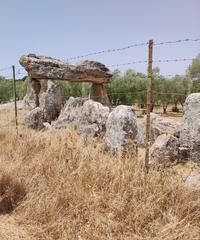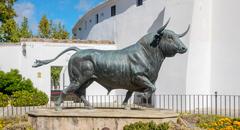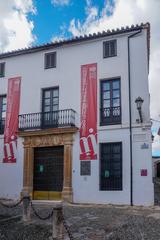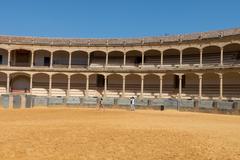Necrópolis De Los Gigantes: Visiting Hours, Tickets, and Historical Sites in Ronda, Spain
Date: 14/06/2025
Introduction: Discovering Ronda’s Prehistoric Legacy
Set amidst the breathtaking landscape of the Serranía de Ronda, the Necrópolis De Los Gigantes stands as one of Andalusia’s most significant prehistoric sites. This megalithic necropolis, dating from the late Neolithic through the Bronze Age (c. 3000–1800 BCE), features imposing limestone dolmens and collective tombs, offering a rare glimpse into ancient burial traditions and early Iberian society. Local myths attribute these monumental structures to giants, adding to the site’s enduring allure and cultural mystique (Spanish Plains; Rediscovering Emily).
Located just minutes from Ronda’s historic center, the necropolis is easily accessible and provides an immersive experience for history enthusiasts, families, and curious travelers. Visitors can explore four primary dolmens, marvel at engraved motifs and grave goods, and enjoy panoramic views of the Andalusian countryside (Ronda Today; Malaga Hoy). This guide delivers all the essential information, including visiting hours, ticketing, accessibility, and tips for combining your trip with Ronda’s other historical and cultural treasures.
Table of Contents
- Introduction
- Prehistoric and Megalithic Context
- Historical Discovery and Archaeological Insights
- Architectural Features and Construction
- Funerary Practices and Social Organization
- Artistic and Symbolic Elements
- Cultural and Comparative Significance
- Visiting Hours and Ticket Information
- Site Access and Directions
- Accessibility and Visitor Tips
- Guided Tours and Interpretation
- Site Layout and Best Photo Spots
- Nearby Attractions and Combined Visits
- Seasonal Events and Local Culture
- Sustainable Tourism and Preservation
- Frequently Asked Questions (FAQ)
- Conclusion and Recommendations
- References
Prehistoric and Megalithic Context
The Serranía de Ronda has been inhabited since the Neolithic era (c. 6000–3000 BCE). Its earliest communities practiced agriculture, animal husbandry, and constructed enduring megalithic monuments. The Necrópolis De Los Gigantes, built from massive limestone slabs, demonstrates the communal effort and technical expertise required to create such collective burial sites (Spanish Plains). These structures are part of a broader network of Andalusian megalithic sites, including the Dolmen de Menga and Dolmen de Soto, reflecting widespread ritual and social practices throughout southern Iberia (Ronda Today).
Historical Discovery and Archaeological Insights
Archaeological investigation of the Necrópolis De Los Gigantes began in the late 19th and early 20th centuries, revealing a complex funerary landscape of dolmens and collective tombs. The site’s monumental scale led to legends of giants, but ongoing research shows that its builders were organized communities skilled in engineering and ritual (Rediscovering Emily; Spanish Plains).
Architectural Features and Construction
The necropolis features four primary tombs, each constructed with upright limestone orthostats and heavy capstones, forming rectangular or polygonal chambers. Some tombs have entrance corridors, while others are simple chambers. Their orientation suggests possible alignment with astronomical events, adding to the site’s spiritual significance (Explored by Marta). The effort required to quarry, transport, and assemble the stones points to a highly organized society.
Funerary Practices and Social Organization
Excavations have identified collective burials, with multiple individuals interred alongside grave goods such as pottery, flint tools, beads, and bone implements. These findings indicate a belief in an afterlife, as well as the existence of social hierarchies and communal rituals. Anthropological studies of the skeletal remains reveal a physically active population, with inclusivity across ages and sexes (Spanish Plains).
Artistic and Symbolic Elements
Several tombs are decorated with engraved geometric motifs and schematic human figures. The use of red ochre pigment on some artifacts suggests symbolic or ritualistic practices related to ancestor worship and funerary rites (Spanish Plains).
Cultural and Comparative Significance
The Necrópolis De Los Gigantes is closely linked to other prehistoric sites in the region, such as the Cueva de la Pileta and the dolmens of Antequera. It provides key evidence of the transition from hunter-gatherer to sedentary, stratified societies in southern Iberia. Comparisons with other Iberian megalithic sites highlight the uniqueness of Ronda’s necropolis in terms of scale, architecture, and artifact diversity (Rediscovering Emily; Wikipedia: Necrópolis megalítica de la Planilla).
Visiting Hours and Ticket Information
- Hours: The site is generally open from 9:00 AM to 6:00 PM daily, with variations possible based on the season. It is advisable to check current hours with the Ronda Tourism Office or official websites before visiting.
- Tickets: Entry is free; there are no ticket booths as of June 2025. Guided tours, if available, may require advance booking and have associated fees.
- Seasonal Closures: The site is typically closed on major public holidays.
Site Access and Directions
- By Car: A 10-minute drive from Ronda’s city center, with parking available nearby on unpaved surfaces.
- By Public Transport: Buses and trains reach Ronda, but not the necropolis directly. From Ronda, take a taxi or walk (30–45 minutes).
- By Foot/Bike: Ideal for those wanting to explore the countryside and other archaeological sites (Ronda Today).
- GPS: Listed on Google Maps and Mapcarta.
Accessibility and Visitor Tips
- Mobility: The terrain is uneven with gravel and rocky paths. Some areas may be challenging for visitors with mobility issues. Wheelchairs and strollers may require assistance.
- What to Bring: Wear sturdy shoes, bring water, sun protection, and a camera.
- Best Times: Early morning or late afternoon for cooler weather and optimal photography conditions.
- Facilities: No restrooms, shelters, or on-site amenities. Ronda’s city center offers full services (Voyage Tips).
Guided Tours and Interpretation
- Guided Tours: Offered by local operators and through the Ronda Tourism Office, often as part of a broader historical or cultural itinerary. Booking ahead is recommended.
- Self-Guided Visits: Research the site beforehand or use digital guides. While the VoiceMap GPS Audio Guide does not cover the necropolis, it is useful for other Ronda landmarks.
Site Layout and Best Photo Spots
- Tomb 1: Five large capstones over its corridor.
- Tomb 2: Parallel standing stones with stone slab remnants.
- Tomb 3: Less defined due to past disturbance.
- Tomb 4: Six orthostats and two large head slabs (Malaga Hoy).
The elevated setting provides panoramic views of the Serranía de Ronda, ideal for photography and quiet exploration.
Nearby Attractions and Combined Visits
Enhance your trip by visiting:
- Dolmens of Antequera
- Cueva de la Pileta (Paleolithic cave art)
- Puente Nuevo Bridge and Ronda’s Old Town
- Acinipo Roman ruins
- White villages (Pueblos Blancos) such as Montecorto, Montejaque, and Benaoján (Adventure Backpack; Mapcarta)
Seasonal Events and Local Culture
Ronda’s calendar features vibrant festivals, such as the Feria de Pedro Romero in September and Semana Santa processions. Visiting during these times provides a dynamic cultural experience alongside your archaeological exploration (Adventure Backpack).
Sustainable Tourism and Preservation
- Respect the Site: Stay on marked paths, do not climb on or remove stones.
- Leave No Trace: Carry out all litter.
- Support Local Guides and Museums: Your participation helps fund preservation.
- Protected Status: The necropolis is a declared Bien de Interés Cultural (BOE).
Frequently Asked Questions (FAQ)
Q: What are the visiting hours?
A: Generally 9:00 AM–6:00 PM; check with official sources for seasonal changes.
Q: Is there an entrance fee?
A: No, entry is free. Guided tours may have associated costs.
Q: Are guided tours available?
A: Yes, through the Ronda Tourism Office and local operators.
Q: Is the site suitable for those with limited mobility?
A: Terrain is uneven and may be challenging. Some accommodations exist; contact the tourism office for details.
Q: Can I take photos?
A: Yes, but do not touch or climb on the stones to protect the site.
Q: How do I get there from Ronda?
A: By car, taxi, or a 30–45 minute walk from the city center.
Conclusion and Final Recommendations
The Necrópolis De Los Gigantes offers an unparalleled journey into Andalusia’s prehistoric past, blending monumental megalithic architecture with the beauty of the Serranía de Ronda. Free entry, accessible visiting hours, and the option of guided tours make it a rewarding stop for history buffs and casual travelers alike. Combine your visit with Ronda’s other archaeological and cultural sites for a well-rounded experience. For updates on hours, tours, and events, consult the Ronda Tourism Office or download the Audiala app for interactive maps and audio guides.
Support responsible tourism—respect the archaeological heritage, stay informed, and help preserve this unique window into the ancient world for generations to come.
References
- Spanish Plains: https://www.spanishplains.com/ronda-spain-a-whirlwind-of-history-culture-and-breathtaking-views/
- Rediscovering Emily: https://www.rediscovering-emily.com/blog/guide-to-visiting-ronda
- Ronda Today: https://rondatoday.com/
- Turispanish: https://turispanish.com/office/ronda-spain-tourism-office/
- Wikipedia: Necrópolis megalítica de la Planilla: https://es.wikipedia.org/wiki/Necr%C3%B3polis_megal%C3%ADtica_de_la_Planilla
- Ronda Today Printable Guide: https://rondatoday.com/the-ronda-today-printable-guide/
- Malaga Hoy: https://www.malagahoy.es/ocio/necropolis-megalitica-Planilla-Ronda-arqueologica_0_158084482.html
- Adventure Backpack: https://adventurebackpack.com/ronda-culture/
- Mapcarta: https://mapcarta.com/N9407170655
- BOE: https://www.boe.es/diario_boe/txt.php?id=BOE-A-1994-16516
- Voyage Tips: https://www.voyagetips.com/en/things-to-do-in-ronda/
- Explored by Marta: https://exploredbymarta.com/travel/spain/ultimate-bucket-list-things-to-do-in-ronda-spain-map/



